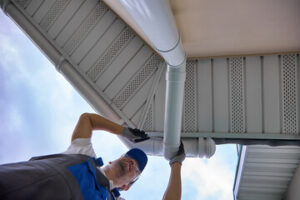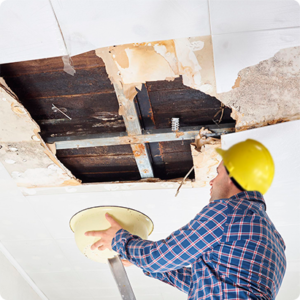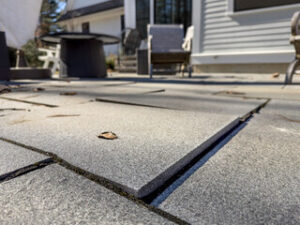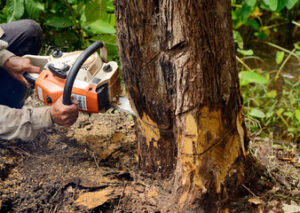Gutter Cleaning is one of the most dreaded household chores. Clogged gutters can cause basement flooding, roof damage, sagging fascia boards and rafter tails, and encourage mold growth.

The best way to keep your gutters clean is to hire a professional. They can do the job more thoroughly, safely, and efficiently.
Gutter cleaning involves removing leaves, dirt, twigs, and debris that clog gutters and downspouts and prevent water from flowing properly. This task is typically done by hand or with scoops and often requires a ladder or other climbing equipment. Professionals use specialized tools like high-powered leaf blowers, extensions, and poles to tackle hard-to-reach areas, including roof valleys and behind chimneys. They also have a variety of safety gear, including harnesses and work gloves. This protects them from falling off the ladder and provides protection from sharp or contaminated objects.
Gutters are an important part of a home’s structure, directing rainwater away from the foundation and roof to avoid costly water damage. They are most effective when they’re free-flowing, but clogged gutters can overflow, stain the exterior of the house, and lead to water infiltration. Clogged gutters can also encourage the growth of mold and mildew, which degrade the quality and appearance of a building’s exterior.
Regular gutter cleaning is the best way to maintain your home’s structural integrity and protect it from water damage. In addition to preserving the curb appeal of your property, it can also reduce maintenance costs and prolong the lifespan of your roof and foundation.
Clogged gutters provide the ideal habitat for birds, rodents, and other pests. Their nests can block water flow, causing overflow and leaks. The rotting debris can also promote the growth of harmful bacteria and other organisms that can contaminate water supplies, affecting your health and the well-being of your family.
When you choose a professional gutter cleaner, they will remove all debris and flush the gutters and downspouts with water to ensure a thorough cleaning. The company will also inspect the gutters and downspouts for signs of wear or damage. Choosing a licensed and insured company will ensure you are getting a quality service at an affordable price.
Prevents Ice Dams
Gutter cleaning prevents ice dams from forming, which can be costly to fix. Ice dams are a result of snow melt and cold temperatures. As the snow melts, it drips down the roof toward the gutter where it re-freezes. This re-freezing creates a dam that blocks the drainage system and can cause water to leak down into the attic or into the house itself. Ice dams can also pull shingles off the roof and break down the wall structure below. Gutter cleaning removes the debris that leads to ice dams and ensures that your gutters can drain properly.
Gutters are designed to collect and funnel rainwater away from your foundation. However, if your gutters are clogged with leaves and other debris, they can’t do their job. Clogged gutters can cause rainwater to pool on the roof, which can lead to leaks and other damage to your home’s interior and exterior.
A well-maintained gutter system keeps water flowing smoothly and minimizes basement flooding. This helps to prevent the growth of mildew and mold, which can contaminate your home’s interior and affect your family’s health. It also protects your belongings from water damage and preserves the integrity of your home’s foundation.
Clogged gutters are a breeding ground for insects, including rodents and mosquitoes. Regular gutter cleaning eliminates pests and their nests, preventing them from infesting your home. It also prevents the accumulation of decomposing organic matter that can pollute your home’s water supply and encourage the growth of mildew and mold. In addition, clean gutters are a safe place for children to play and learn. Gutter cleaning is a simple maintenance task that can have a big impact on the safety and comfort of your home. It’s important to schedule this service at least twice a year, during the spring and fall, or whenever your home experiences heavy precipitation. However, if your house is located close to trees or has overhanging branches, it may need more frequent cleaning. It’s best to consult with a professional about the appropriate frequency for your home’s needs. They’ll take into account factors like the size of your home and its location to determine a proper gutter maintenance plan.
Prevents Foundation Damage
Gutters are designed to funnel rainwater and soil away from the foundation of your home. Without gutters, the underlying soil will become saturated and water will build up against your foundation. This can lead to basement flooding, wall cracks, and structural instability. However, if your home is located in an area that receives high amounts of rainfall or has a clay soil composition, the water will easily absorb into the ground and create a negative pressure around your foundation. Gutters help to prevent this by draining the excess moisture and allowing it to escape via downpipes and into stormwater sewer systems.
When gutters are clogged, rainwater will overflow and spill onto the ground and into crawl spaces, basements, and exterior walls. This floods the interior of living areas and can damage furniture, electronics, and other items stored in these spaces. Regular gutter cleaning helps to minimize this risk by ensuring that rainwater is properly channeled away from the foundation.
Gutter cleaning is an important service that protects the investment you’ve made in your home. It also extends the lifespan of your roof by preventing water from seeping under shingles, which can cause wood rot, shingle lifting, and leaks. By keeping your gutters clean, you can avoid the costly repairs and replacements associated with clogged gutters.
Clogged gutters can also damage your property’s landscaping by washing out topsoil, plants, and trees. Over time, this can result in unsightly stains and a lack of visual appeal for your home’s exterior. Gutter cleaning services remove clogs and ensure that water is flowing correctly, protecting your landscaping and increasing the curb appeal of your home.
When you hire a professional gutter cleaning company to clean your gutters, it is important to choose one that is licensed, insured, and bonded. While it may cost a little more than hiring a weekend warrior who has a truck and ladder, it is well worth the peace of mind that comes with choosing a licensed professional. If you are unsure whether your gutter cleaners have these credentials, contact the local municipality for verification.
Increases Home Value
Clogged gutters are a major turn-off for potential homebuyers. They look unsightly and may even cause water damage to the property. Regular cleaning will ensure that your gutters are functioning properly and protect the landscaping of your property. Clean gutters are also essential for reducing the risk of pest infestation. Standing water in clogged gutters is a breeding ground for mosquitoes, centipedes, and termites. Regular gutter cleaning will eliminate these breeding areas and reduce the need for costly pest control services.
Gutter cleaning is one of the easiest and most effective ways to improve your curb appeal. When your gutters are clean and uncluttered, they give off a polished and well-maintained appearance that can increase the value of your home.
If you’re planning to sell your home in the future, hiring professional gutter cleaners is the best way to keep your property in pristine condition and maximize its value. It’s important to remember that prospective buyers will be judging your home based on its appearance as well as its function.
A cluttered or overflowing home can make buyers think that you’re not taking care of your property, and they might be willing to pay less for it. Gutter cleaning is an inexpensive, easy way to improve your property’s curb appeal and increase its value.
Inexperienced homeowners who try to perform their own gutter cleaning could end up causing costly damage to their roof or siding. Incorrect ladder placement, mishandling of tools, and aggressive cleaning methods are common mistakes that can lead to expensive repair bills. Hiring professional gutter cleaners will eliminate the risk of these costly mistakes and ensure that your gutters are cleaned properly. In addition, professionals have the tools and expertise to complete the job quickly and efficiently. This means that you’ll save money on both labor and equipment costs. Hiring a professional gutter cleaner is the safest and most cost-effective option.


